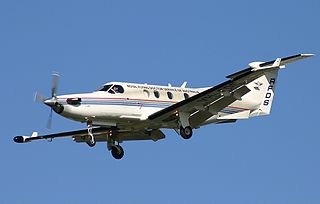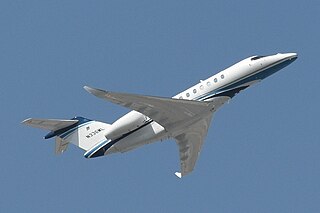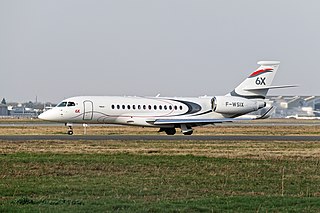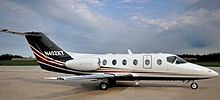
A business jet, private jet, or bizjet is a jet aircraft designed for transporting small groups of people, typically business executives and high-ranking associates. Business jets are generally designed for faster air travel and more personal comfort than commercial aircraft, and may be adapted for other roles, such as casualty evacuation or express parcel deliveries, and some are used by public bodies, government officials, VIPs, or even the military.

The Learjet 60 is a mid-size cabin, medium-range business jet aircraft manufactured by Bombardier Aerospace in Wichita, Kansas. Powered by two Pratt & Whitney Canada PW305A engines, it has a range of 2,405 nautical miles (4,454 km) with NBAA 100 nmi (190 km) reserves, ISA. In July 2012 Bombardier Aerospace announced a temporary "production pause" of the latest variant Learjet 60XR to begin in the fourth quarter of 2012.

The British Aerospace 125 is a twinjet mid-size business jet. Originally developed by de Havilland and initially designated as the DH.125 Jet Dragon, it entered production as the Hawker Siddeley HS.125, which was the designation used until 1977. Later on, more recent variants of the type were marketed as the Hawker 800.

The Hawker 800 is a mid-size twinjet corporate aircraft. It is a development of the British Aerospace 125, and was assembled by Hawker Beechcraft.

The Pilatus PC-12 is a pressurized, single-engined, turboprop aircraft manufactured by Pilatus Aircraft of Stans, Switzerland since 1991. It was designed as a high-performance utility aircraft that incorporates a large aft cargo door in addition to the main passenger door. Due to its efficient, high-utility design, the PC-12 is used by a large variety of operators. The main use for the aircraft is corporate transportation, but it is also used by fractional and small regional airlines, air-ambulance operators, and many government agencies, such as police departments and armed forces. The 2,000th PC-12 was delivered in May 2023.

The Hawker 400 is a light business jet. Initially designed and built by Mitsubishi, it has been further developed and updated by the Beech Aircraft Company, now part of Textron Aviation. A military version, the T-1 Jayhawk was also produced. In total, over 900 Hawker 400s have been delivered. In 2017, Hawker began to offer a manufacturer supported upgrade package known as the Hawker 400XPR. The new modifications are intended to reduce fuel consumption and improve range.

The Cessna Citation is a family of business jets by Cessna that started in 1972 with the entry into service of the first model. In the fifty years following the 1969 first flight, more than 7,500 Citations were delivered, forming the largest business jet fleet. Deliveries reached 8,000 by 2022, while logging over 41 million flight hours.

The Hawker 4000, originally known as the Hawker Horizon, is a super-midsize business jet developed by Hawker Beechcraft.

The Beechcraft Premier I is a light business jet aircraft manufactured by the Beechcraft division of Hawker Beechcraft. The aircraft was designed to compete with the Cessna CitationJet series of aircraft.

The Beechcraft Super King Air family is part of a line of twin-turboprop aircraft produced by Beechcraft. The Model 200 and Model 300 series were originally marketed as the "Super King Air" family; the "Super" designation was dropped in 1996. They form the King Air line together with the King Air Model 90 and 100 series.

The Cessna Citation Excel is an American midsize business jet in the Cessna Citation family. Announced in October 1994, the Model 560XL first flew on February 29, 1996, certification was granted in April 1998, and over 1,000 have been delivered. The 2,100 nmi-range (3,900 km), 20,200 lb MTOW jet is powered by two 3,650–4,080 lbf (16.2–18.1 kN) PW545 turbofans, has the cruciform tail and unswept supercritical wing of the Citation V (560), and a slightly shortened Citation X stand-up cabin. The XLS 2004 update had upgraded engines and a glass cockpit and the 2008 XLS+ had upgraded engines and a revised nose.
The Spectrum S-40 Freedom was a business jet developed by Spectrum Aeronautical. The aircraft was first announced at the 2006 NBAA Conference in Orlando, Florida.

The Cessna CitationJet/CJ/M2 are a series of light business jets built by Cessna, and are part of the Citation family. Launched in October 1989, the first flight of the Model 525 was on April 29, 1991. Federal Aviation Administration (FAA) certification was awarded on October 16, 1992, and the first aircraft was delivered on March 30, 1993. The CJ series are powered by two Williams FJ44 engines; the design uses the Citation II's forward fuselage with a new carry-through section wing and a T-tail. The original CitationJet model has been updated into the CJ1/CJ1+/M2 variants; additionally, the CJ1 was stretched into the CJ2/CJ2+ which was built between 2000 and 2016. The design was then further developed into the CJ3/CJ3+, built from December 2004 to present, and finally into the CJ4 which has been built since 2010. By June 2017, 2,000 of all variants had been delivered.

The Cessna Citation V is a business jet built by Cessna that was in production from 1989 until 2011. During that time, 774 such craft were made. The first Model 560 prototype, a stretched version of the Citation S/II, flew in August 1987 and was certified on December 9, 1988.

The Gulfstream G400, G500, and G600 (GVII) are twin-engine business jets designed and produced by Gulfstream Aerospace. The aircraft are designated Gulfstream GVII-G500 and GVII-G600 in their type certificate.

The Cessna Citation Sovereign is an American business jet developed by Cessna, part of the Cessna Citation family. Announced at the 1998 NBAA convention, the Model 680 made its maiden flight in February 2002, certification was awarded on June 2, 2004, and deliveries began in late September. The Citation Excel fuselage was stretched and joined with an all-new, larger wing and more powerful Pratt & Whitney Canada PW306C engines for increased maximum takeoff weight and a 3,200 nmi (5,900 km) range. The improved Sovereign+ was announced at the October 2012 NBAA for a first flight in April 2013 and deliveries in December, with added winglets and an improved flight deck and engines.

The Gulfstream G280 is a twin-engine business jet built by Israel Aerospace Industries (IAI) for Gulfstream Aerospace. It began delivery to users in 2012.

The Cessna Citation Longitude is a business jet produced by Cessna, part of the Cessna Citation family. It remains the largest business jet by Cessna. Announced at the May 2012 EBACE, the Model 700 made its first flight on October 8, 2016, with certification obtained in September 2019. The aluminum airframe has the fuselage cross-section of the Citation Latitude, stretched by a seat row. Powered by Honeywell HTF7000 turbofans, it has a new ~28° swept wing and a T-tail for a 3,500 nmi (6,500 km) range.

The Cessna Citation Latitude is a business jet built by Cessna. The Model 680A was announced at the 2011 NBAA convention, the prototype first flew on 18 February 2014, it achieved FAA certification on June 5, 2015, and first deliveries began on August 27. It retains the Model 680 Sovereign wing, twin P&WC PW306D turbofans and cruciform tail and adds a new stand-up circular fuselage with a flat floor, which was kept in the stretched, re-winged, and re-engined Cessna Citation Longitude.

The Dassault Falcon 6X is a large, long-range business jet developed by Dassault Aviation in France. Its precursor, the Falcon 5X twinjet, was launched in 2013, rolled-out in 2015 and made its first flight on July 5, 2017, but its development was frozen as its Safran Silvercrest engine failed to meet performance objectives. In December 2017, the Falcon 6X was launched as a stretched version with PW812D turbofans, made its first flight on 10 March 2021, and entered service on 30 November 2023.





















